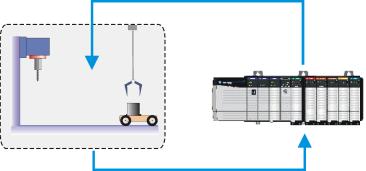
An industrial automation system can be seen as built from two conceptually different parts: controller and plant. The controller performs data processing, communication and decision making hardware and software, the plant contains material-processing part of equipment.
Depending on the accuracy of modeling, the model of plant may include components for each drive, motor, valve, electric relay, sensor, actuator, and other elementary pieces of equipment. These component models may be integrated to composite models of equipment units, such as machine tool, or other material processing and storage units.
Modeling of discrete controllers using place-transition formalisms is also well developed. The use of NCES just simplifies the assembling of the model from the components. Besides, such key features of NCES as event/data connections closely correspond to the latest trends in controller design methodology presented in new international standard IEC61499.

Figure 1. An example of automated drilling station.
Connection between controller and plant is implemented via logic level signals which are modeled using condition arcs. Event signals are used in both models of plant and controller but not between them. In the model of plant the events may be used for example, to model the causal behavior of sensors influenced from the observed processes. In controllers the event signals model the actions explicitly defined as event-driven (say, event-connected function blocks in IEC1499), as well as a lot of other internal operations: procedure calls, setting/resetting variables, etc.

Figure 2. Closed-loop NCES model of the automated drilling station.
Modeling can be performed in either open-loop or closed loop way. The open loop modeling usually is a more economical solution which bases on the partial model of controller inputs which help to generate the outputs and then verify their correctness. The closed-loop model requires a comprehensive model of plant's dynamic. It does not only generate the inputs of the controller but also receives the outputs and correspondingly modifies its internal state. In both cases, however, inputs and outputs of both parts are modeled as NCES modules with condition signal inputs and outputs.
© 2003,
Martin
Luther University of Halle-Wittenberg, Automation Technology
Lab.
Recommended
browser: IE4.0 or higher
Document created and maintained by: Valeriy V. Vyatkin